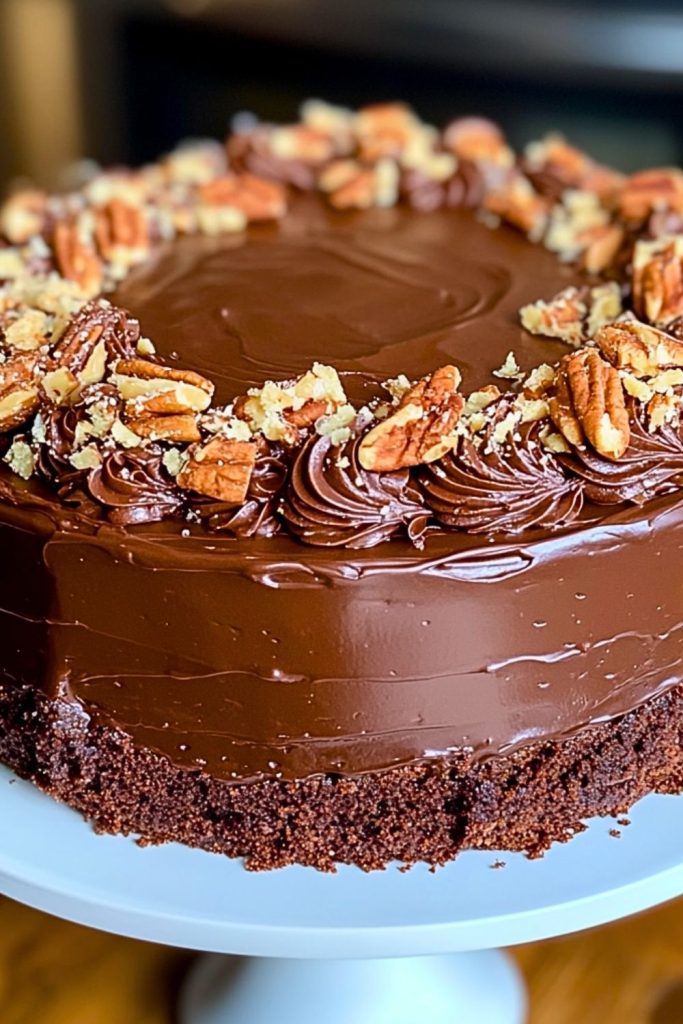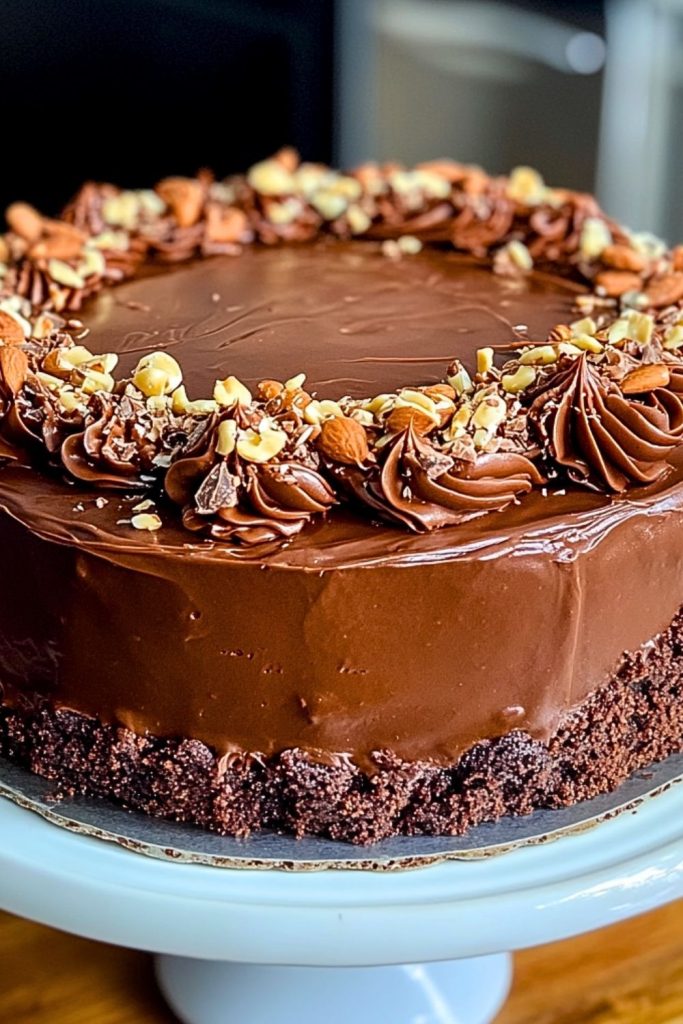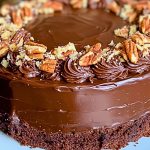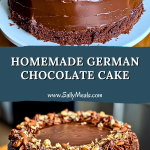There’s something magical about the moment you slice into a rich, glossy chocolate cake and discover layers of flavor and texture inside. That’s exactly what I feel every time I make this Homemade German Chocolate Cake. It’s my go-to dessert when I want something show-stopping yet deeply comforting—a cake that’s as nostalgic as it is decadent.

The layers of moist chocolate cake, silky coconut-pecan filling, and dreamy chocolate frosting come together in a way that just feels indulgent. I’ve made this for birthdays, family dinners, and quiet weekends when I need a little sweet escape. Each bite brings out the warmth of toasted pecans, the chewiness of coconut, and the deep chocolatey notes that make this cake unforgettable.
Why You’ll Love This Homemade German Chocolate Cake
This isn’t just any chocolate cake—it’s a dessert with character and complexity. The combination of the velvety chocolate base with that signature coconut-pecan filling creates layers of contrast in every bite. The frosting is smooth and rich, but not too sweet, allowing the nutty, caramel-like filling to shine. Plus, it looks like something straight out of a bakery display, making it perfect for celebrations or when you want to treat yourself or loved ones to something truly special.
What Kind of Chocolate Should I Use for Homemade German Chocolate Cake?
When it comes to this cake, the chocolate you choose really does make a difference. Traditionally, German’s Sweet Chocolate—a mild, slightly sweeter dark chocolate developed by Samuel German—is what gives the cake its name and unique flavor. It’s not as bitter as regular dark chocolate, which allows the other ingredients, like coconut and pecans, to shine.
But if you can’t find German’s chocolate, you can still use a high-quality semi-sweet or bittersweet chocolate. Just be aware it may slightly change the flavor, making it a bit richer and less sweet. I personally like to combine semi-sweet chocolate in the cake batter with a touch of brewed coffee or espresso to deepen the chocolate profile even more.
Options for Substitutions
Even though the original recipe has stood the test of time, I know sometimes we need to make do with what’s in our pantry. Here are a few great substitutions that still preserve the cake’s delicious essence:
- Chocolate Substitute: If you don’t have German’s chocolate, mix semi-sweet chocolate with a bit of sugar to mimic the sweetness.
- Butter Alternatives: You can use plant-based butter or even a neutral oil like avocado or canola oil if needed.
- Eggs: For a vegan version, flax eggs or commercial egg replacers work, although the texture might be a bit denser.
- Dairy-Free: Use coconut milk or almond milk for both the cake and the coconut-pecan filling.
- Pecans: Walnuts can stand in if you’re short on pecans—they’ll give a similar crunch and flavor profile.
- Coconut: Unsweetened shredded coconut is fine if that’s what you have, though sweetened flakes add more chew and moisture.
Ingredients for This Homemade German Chocolate Cake
Each ingredient in this recipe has a purpose, contributing to the flavor, texture, or structure of the cake. Here’s what you’ll need and why it matters:
- All-Purpose Flour
This forms the foundation of the cake, giving it structure without making it too dense. - German’s Sweet Chocolate (or Semi-Sweet Chocolate as a substitute)
The star of the show—this chocolate provides the cake’s signature smooth, sweet cocoa flavor. - Granulated Sugar
Adds sweetness and helps create that moist crumb we all love in chocolate cakes. - Butter
Essential for richness and tenderness. It also gives a beautiful depth of flavor when creamed with sugar. - Egg Yolks and Egg Whites
The yolks add richness and moisture, while the whipped whites create lightness and lift. - Buttermilk
Its slight tanginess enhances the chocolate flavor and makes the crumb tender. - Vanilla Extract
A touch of vanilla balances the chocolate and adds warmth to the overall flavor. - Baking Soda
Reacts with the acidity in the buttermilk to help the cake rise beautifully. - Salt
Just a pinch enhances every other flavor and keeps the sweetness in check. - Sweetened Shredded Coconut
The chewy texture and sweet tropical note make the coconut-pecan filling unforgettable. - Chopped Pecans
These bring a rich, buttery crunch that perfectly contrasts the soft cake layers. - Evaporated Milk
Used in the filling, it provides creaminess without being too heavy. - Egg Yolks (for the filling)
Help thicken the coconut-pecan filling and give it that luscious, custard-like texture. - Brown Sugar
Adds a caramel depth to the filling that granulated sugar just can’t match. - Chocolate Frosting (homemade or your favorite brand)
Smooth, glossy, and rich—this finishes the cake and brings everything together in chocolaty harmony.

Step 1: Prep Your Pans and Ingredients
Start by preheating your oven to 350°F (175°C). Grease and flour three 9-inch round cake pans (or line the bottoms with parchment paper for easy release). While the oven heats, melt the German’s Sweet Chocolate in a heatproof bowl over simmering water or in the microwave using 20-second bursts—stirring until smooth. Let it cool slightly.
Step 2: Cream Butter and Sugar
In a large mixing bowl, beat the butter until smooth and creamy. Gradually add in the granulated sugar, beating on medium speed until light and fluffy—about 3–5 minutes. This step ensures a light, airy texture in the finished cake.
Step 3: Add Yolks, Chocolate, and Vanilla
Beat in the egg yolks, one at a time. Then pour in the melted chocolate and add the vanilla extract. Mix until fully incorporated and smooth.
Step 4: Alternate Dry and Wet Ingredients
In a separate bowl, whisk together the flour, baking soda, and salt. With the mixer on low, alternately add the dry mixture and buttermilk to the chocolate batter—starting and ending with the dry ingredients. Mix until just combined. Don’t overmix; we want a tender crumb!
Step 5: Fold in Whipped Egg Whites
In a clean bowl, beat the egg whites until stiff peaks form. Gently fold them into the batter in three additions. This step is key to keeping the cake light and fluffy.
Step 6: Bake
Divide the batter evenly between your prepared pans. Bake for 25–30 minutes, or until a toothpick inserted in the center comes out clean. Let the cakes cool in the pans for 10 minutes, then turn them out onto a wire rack to cool completely.
Step 7: Make the Coconut-Pecan Filling
While the cakes cool, prepare the filling. In a saucepan over medium heat, whisk together evaporated milk, brown sugar, egg yolks, and butter. Cook, stirring constantly, until thickened (about 10–12 minutes). Remove from heat and stir in vanilla, pecans, and shredded coconut. Let it cool completely—it will thicken more as it sits.
Step 8: Assemble the Cake
Place one cake layer on a serving plate. Spread a third of the coconut-pecan filling over the top. Repeat with the second layer and more filling. Place the third cake layer on top and frost the entire cake with your chocolate frosting, smoothing the sides and top. Garnish the top with a final ring of filling or extra chopped pecans and coconut if you’d like.
How Long to Cook the Homemade German Chocolate Cake
Each cake layer will need about 25 to 30 minutes in a 350°F (175°C) oven. You’ll know they’re ready when the centers spring back lightly to the touch and a toothpick inserted in the center comes out clean (a few moist crumbs are okay—just no raw batter).
Once baked, let the layers rest in their pans for about 10 minutes before turning them out onto a wire rack. Allow them to cool completely before assembling—warm cake will melt the filling and frosting, which we definitely don’t want.
Tips for Perfect Homemade German Chocolate Cake
Getting this cake just right is all about the details. Here are my top tips to make sure your version turns out beautifully every time:
- Room Temperature Ingredients: Let your butter, eggs, and buttermilk sit out for about 30 minutes before using. This helps everything mix evenly and gives the cake a better texture.
- Don’t Skip Whipping the Egg Whites: Folding in stiff egg whites at the end makes the cake lighter and helps it rise without being dense.
- Use Fresh Pecans and Coconut: Stale nuts or dried-out coconut can dull the overall flavor. Toast the pecans lightly for even more richness.
- Cool the Filling Completely: It should be thick and creamy when you layer it into the cake—if it’s too warm, it can become runny and messy.
- Level Your Layers: If your cakes domed while baking, trim the tops with a serrated knife so they stack neatly.
- Use a Cake Turntable: If you have one, it makes frosting the sides so much easier and more even.
- Chill Before Serving: After assembling, chill the cake for about an hour for clean slicing and firmer frosting.
Watch Out for These Mistakes While Cooking
Even a well-practiced recipe like this one can go sideways with just a few missteps. Keep these common pitfalls in mind to ensure your Homemade German Chocolate Cake comes out flawless:
- Overbaking the Layers: A few extra minutes in the oven can dry out the cake. Start checking for doneness at the 25-minute mark.
- Skipping the Egg White Folding Step: This step adds crucial lightness. Stirring them in too aggressively or skipping them entirely can leave the cake dense.
- Using Hot Filling or Frosting: Always let both cool before assembling the cake—warm filling will melt through your layers and ruin the structure.
- Frosting While the Cake Is Warm: You’ll end up with a runny mess. Let the cake layers cool completely before frosting.
- Overmixing the Batter: Once you add flour, mix gently. Overworking the batter can create a tough cake.
- Uneven Layer Thickness: Eyeballing the batter distribution can result in lopsided layers. Use a scale or measuring cup for evenness.
- Forgetting to Toast the Pecans: Toasting them really brings out their flavor—don’t skip it if you want that nutty depth.
- Underseasoning: That pinch of salt? It’s not optional—it heightens the sweetness and balances the chocolate and filling.
What to Serve With Homemade German Chocolate Cake?
This cake is rich, sweet, and satisfying on its own—but pairing it with the right side or drink takes the experience to a whole new level.
Freshly Brewed Coffee
The bitterness of black coffee cuts through the richness and complements the chocolate beautifully.
Vanilla Bean Ice Cream
Classic and cool, it offers a creamy contrast to the chewy filling and moist cake layers.
Earl Grey Tea
The floral notes of bergamot enhance the sweetness of the coconut-pecan topping.
Port or Dessert Wine
A small glass of port wine adds sophistication and a fruity counterbalance to the cake’s flavors.
Fresh Berries
Serve with raspberries or strawberries for a pop of color and a tart bite that refreshes the palate.
Banana Slices and Whipped Cream
Layered on the side, these add softness and a mild tropical vibe that works well with coconut.
Coconut Milk Latte
Double up on coconut flavor while adding a smooth, foamy companion to your dessert slice.
Sharp Cheese Board
Believe it or not, a few slivers of sharp white cheddar or goat cheese can provide a savory contrast that cuts the sweetness.
Storage Instructions
A cake like this deserves to be savored beyond the first day—and with proper storage, it stays moist and delicious for several days.
- Room Temperature: If you plan to eat the cake within 1–2 days, you can store it covered at room temp. Use a cake dome or gently wrap it in plastic wrap.
- Refrigerator: For longer storage (up to 5 days), keep it in the fridge. Wrap it tightly in plastic wrap or store in an airtight container. Let slices sit at room temp for about 30 minutes before eating—they taste best when slightly softened.
- Freezer: Yes, you can freeze it! Wrap individual slices or full layers (unfrosted) in plastic wrap and foil, then freeze for up to 3 months. Thaw overnight in the fridge before serving.
- Filling & Frosting Note: The coconut-pecan filling holds up well in the fridge. If making it ahead, store in a sealed container and stir before spreading.
Estimated Nutrition
Here’s an approximate breakdown per slice (assuming the cake yields 12 generous slices):
- Calories: 580–650 kcal
- Total Fat: 35g
- Saturated Fat: 18g
- Cholesterol: 110mg
- Sodium: 300mg
- Total Carbohydrates: 65g
- Dietary Fiber: 3g
- Sugars: 45g
- Protein: 6g
Note: These numbers can vary depending on the exact brands and substitutions you use (e.g., dairy-free milk, lower sugar chocolate).
Frequently Asked Questions
What makes German Chocolate Cake different from other chocolate cakes?
It’s all about the signature coconut-pecan filling. While most chocolate cakes rely on a rich ganache or buttercream, German Chocolate Cake gets its unique character from a custard-like filling loaded with shredded coconut and chopped pecans.
Can I make this cake ahead of time?
Absolutely. You can bake the layers a day or two ahead and store them wrapped at room temp or in the fridge. The filling can also be made in advance and kept chilled. Assemble the cake the day of serving for best freshness.
Can I turn this into a sheet cake instead of a layered cake?
Yes! Just pour the batter into a greased 9×13-inch pan and bake for 35–40 minutes. Then spread the filling over the top—no layering needed.
What if I don’t have buttermilk?
No problem. Mix 1 tablespoon of lemon juice or vinegar with 1 cup of milk and let it sit for 5 minutes to create a quick buttermilk substitute.
Is it necessary to toast the pecans?
It’s not mandatory, but toasting deepens the flavor and adds a little extra crunch that really enhances the texture of the filling.
Can I use a different frosting instead of chocolate?
Yes. Some people skip the outer chocolate frosting and let the coconut-pecan filling cover the whole cake. Others opt for cream cheese frosting for a tangy twist.
How do I keep the cake from sticking to the pans?
Grease and flour the pans well, and for extra security, line the bottoms with parchment rounds. Let the cake cool slightly before removing.
Can I make this gluten-free or dairy-free?
Yes! Use a gluten-free all-purpose flour blend for a wheat-free version, and substitute plant-based milk, vegan butter, and egg alternatives for a dairy-free, egg-free cake.
Conclusion
Homemade German Chocolate Cake is one of those timeless desserts that never goes out of style. With its layered textures, bold chocolate notes, and sweet, nutty filling—it’s both comforting and celebratory. Whether you’re baking it for a special occasion or simply because you crave something amazing, this cake delivers every single time.
It’s one of my favorite bakes to share, and I hope it becomes one of yours too. Get ready to impress your guests—or just treat yourself—with each irresistible slice.

Homemade German Chocolate Cake
- Prep Time: 40 minutes
- Cooling & Assembly Time: 1 hour 30 minutes
- Cook Time: 30 minutes
- Total Time: 2 hours 40 minutes
- Yield: 12 slices 1x
Description
Get ready to indulge in a show-stopping, bakery-worthy dessert with this Homemade German Chocolate Cake. Rich, moist chocolate cake layers are paired with a luscious coconut-pecan filling and finished with silky chocolate frosting. This cake is the ultimate easy recipe for special occasions or sweet weekend baking. With nostalgic flavor and satisfying texture, it makes the perfect birthday dessert, easy dinner party treat, or even a luxurious breakfast idea for chocolate lovers. Whether you’re baking for a crowd or simply feeding your sweet tooth, this is one of those food ideas that everyone will remember. Sweet, nutty, and chocolatey—it’s pure comfort in cake form.
Ingredients
For the Cake:
- 1 package (4 oz) German’s Sweet Chocolate, melted and cooled
- 2 1/4 cups all-purpose flour
- 1 teaspoon baking soda
- 1/2 teaspoon salt
- 1 cup (2 sticks) unsalted butter, softened
- 2 cups granulated sugar
- 4 large eggs, separated
- 1 teaspoon vanilla extract
- 1 cup buttermilk
For the Coconut-Pecan Filling:
- 1 can (12 oz) evaporated milk
- 1 1/2 cups brown sugar
- 3/4 cup (1 1/2 sticks) unsalted butter
- 4 large egg yolks
- 2 cups sweetened shredded coconut
- 1 1/2 cups chopped pecans
- 1 1/2 teaspoons vanilla extract
For the Frosting:
- 2 cups chocolate frosting (homemade or your favorite store-bought brand)
Instructions
- Preheat oven to 350°F (175°C). Grease and flour three 9-inch round cake pans or line the bottoms with parchment paper.
- Melt the German chocolate and let it cool slightly.
- In a bowl, sift together flour, baking soda, and salt.
- In a large mixing bowl, cream butter and sugar until fluffy.
- Add egg yolks one at a time, beating after each addition. Stir in melted chocolate and vanilla.
- Alternately add dry ingredients and buttermilk to the chocolate mixture, beginning and ending with the dry.
- Beat egg whites until stiff peaks form. Gently fold into the batter.
- Divide the batter evenly among the prepared pans and bake for 25–30 minutes.
- Let cakes cool in pans for 10 minutes, then turn out onto wire racks to cool completely.
- For the filling: In a saucepan, cook evaporated milk, brown sugar, butter, and egg yolks over medium heat, stirring constantly until thickened (about 10–12 minutes). Remove from heat and stir in coconut, pecans, and vanilla. Let cool.
- Assemble the cake: Place one cake layer on a plate. Spread 1/3 of the filling on top. Repeat with second layer and more filling. Add third layer and spread chocolate frosting over the top and sides. Garnish with remaining filling, chopped pecans, or coconut if desired.
- Chill for 1 hour before slicing for clean cuts.

